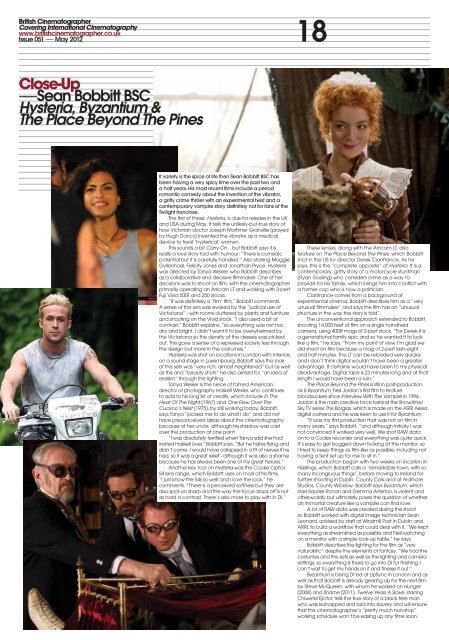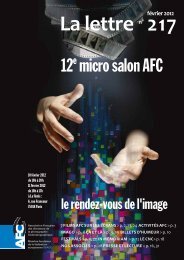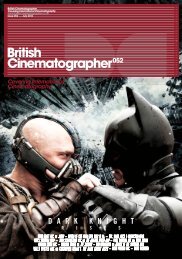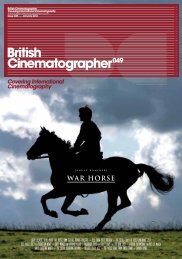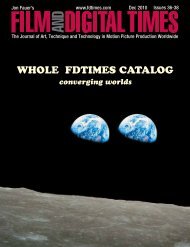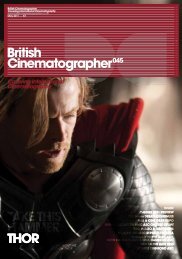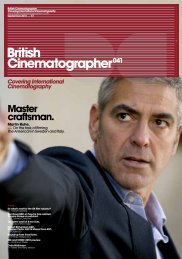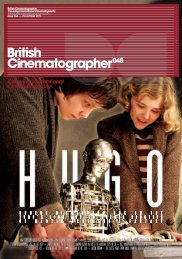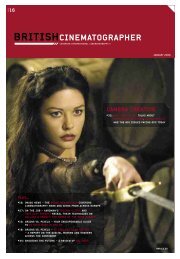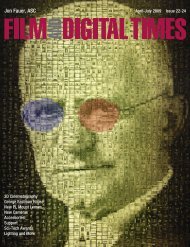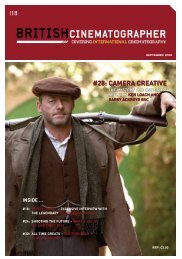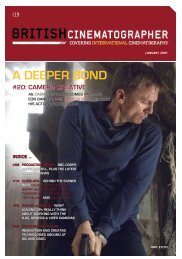British Cinematographer issue 51 - Imago
British Cinematographer issue 51 - Imago
British Cinematographer issue 51 - Imago
Create successful ePaper yourself
Turn your PDF publications into a flip-book with our unique Google optimized e-Paper software.
<strong>British</strong> <strong>Cinematographer</strong><br />
Covering International Cinematography<br />
www.britishcinematographer.co.uk<br />
Issue 0<strong>51</strong> ––– May 2012 18<br />
Close-Up<br />
–––Sean Bobbitt BSC<br />
Hysteria, Byzantium &<br />
The Place Beyond The Pines<br />
If variety is the spice of life then Sean Bobbitt BSC has<br />
been having a very spicy time over the past two and<br />
a half years. His most recent films include a period<br />
romantic comedy about the invention of the vibrator,<br />
a gritty crime thriller with an experimental twist and a<br />
contemporary vampire story definitely not for fans of the<br />
Twilight franchise.<br />
The first of these, Hysteria, is due for release in the UK<br />
and USA during May. It tells the unlikely-but-true story of<br />
how Victorian doctor Joseph Mortimer Granville (played<br />
by Hugh Dancy) invented the vibrator as a medical<br />
device to treat ‘hysterical’ women.<br />
This sounds a bit Carry On... but Bobbitt says it is<br />
really a love story told with humour: “There is comedic<br />
potential but it is carefully handled.” Also starring Maggie<br />
Gyllenhaal, Felicity Jones and Jonathan Pryce, Hysteria<br />
was directed by Tanya Wexler, who Bobbitt describes<br />
as a collaborative and decisive filmmaker. One of her<br />
decisions was to shoot on film, with the cinematographer<br />
primarily operating an Arricam LT and working with 3-perf<br />
Fuji Vivid 500T and 250 stocks.<br />
“It was definitely a ‘film’ film,” Bobbitt comments.<br />
A sense of the era was evoked by the “judicial use of<br />
Victoriana” - with rooms cluttered by plants and furniture<br />
and shooting on the Vivid stock. “I also used a bit of<br />
contrast,” Bobbitt explains, “so everything was not too<br />
airy and bright. I didn’t want it to be overwhelmed by<br />
the Victoriana so the density of the dresses was picked<br />
out. This gave a sense of a repressed society less through<br />
the design but more in the costumes.”<br />
Hysteria was shot on locations in London with interiors<br />
on a sound stage in Luxembourg. Bobbitt says the look<br />
of the sets was “very rich, almost heightened” but as well<br />
as this and “beauty shots” he also aimed for “an idea of<br />
realism” through the lighting.<br />
Tanya Wexler is the niece of famed American<br />
director of photography Haskell Wexler, who continues<br />
to add to his long list of credits, which include In The<br />
Heat Of The Night (1967) and One Flew Over The<br />
Cuckoo’s Nest (1975), by still working today. Bobbitt<br />
says Tanya “picked me to do what I do” and did not<br />
have preconceived ideas about the cinematography<br />
because of her uncle, although his shadow was cast<br />
over the production at one point.<br />
“I was absolutely terrified when Tanya said she had<br />
invited Haskell over,” Bobbitt says. “But he hates flying and<br />
didn’t come. I would have collapsed in a fit of nerves if he<br />
had, so it was a great relief - although it was also a shame<br />
because he has always been one of my great heroes.”<br />
Another key tool on Hysteria was the Cooke Optics<br />
S4 lens range, which Bobbitt uses on most of his films.<br />
“I just know the S4s so well and I love the look,” he<br />
comments. “There is a perceived softness but they are<br />
also spot-on sharp and the way the focus drops off is not<br />
as hard a contrast. There’s also more to play with in DI.”<br />
19<br />
These lenses, along with the Arricam LT, also<br />
feature on The Place Beyond The Pines, which Bobbitt<br />
shot in the US for director Derek Cianfrance. As he<br />
says, this is the “complete opposite” of Hysteria. It is a<br />
contemporary, gritty story of a motorcycle stuntman<br />
(Ryan Gosling) who considers crime as a way to<br />
provide for his family, which brings him into conflict with<br />
a former cop who is now a politician.<br />
Cianfrance comes from a background of<br />
experimental cinema; Bobbitt describes him as a “very<br />
unusual filmmaker” and says the film has an “unusual<br />
structure in the way the story is told”.<br />
The unconventional approach extended to Bobbitt<br />
shooting 14,000 feet of film on a single handheld<br />
camera, using 400ff mags of 2-perf stock. “For Derek it is<br />
a generational family epic and so he wanted it to look<br />
like a film,” he says. “From my point of view I’m glad we<br />
did shoot on film because a mag of 2-perf lasts eight<br />
and half minutes. The LT can be reloaded very quickly<br />
and I don’t think digital wouldn’t have been a greater<br />
advantage. It certainly would have been to my physical<br />
disadvantage. Digital tape is 23 minutes long and at that<br />
length I would have been a ruin.”<br />
The Place Beyond the Pines is still in post-production,<br />
as is Byzantium, Neil Jordan’s first film to feature<br />
bloodsuckers since Interview With The Vampire in 1994.<br />
Jordan is the main creative force behind the Showtime/<br />
Sky TV series The Borgias, which is made on the ARRI Alexa<br />
digital camera and he was keen to use it for Byzantium.<br />
“It was my first production that was not on film in<br />
many years,” says Bobbitt, “and although initially I was<br />
not convinced it worked very well. We shot RAW data<br />
on to a Codex recorder and everything was quite quick.<br />
It’s easy to get bogged down looking at the monitor, so<br />
I tried to keep things as film-like as possible, including not<br />
having a tent set up for me to sit in.”<br />
The production began with two weeks on location in<br />
Hastings, which Bobbitt calls a “remarkable town, with so<br />
many incongruous things”, before moving to Ireland for<br />
further shooting in Dublin, County Cork and at Ardmore<br />
Studios, County Wicklow. Bobbitt says Byzantium, which<br />
stars Saorise Ronan and Gemma Arterton, is violent and<br />
otherworldly but ultimately poses the question of whether<br />
an immortal creature like a vampire can find love.<br />
A lot of RAW data was created during the shoot<br />
so Bobbitt worked with digital image technician Sean<br />
Leonard, advised by staff at Windmill Post in Dublin and<br />
ARRI, to build a workflow that could deal with it. “We kept<br />
everything as streamlined as possible and Neil watching<br />
on a monitor with a simple look-up table,” he says.<br />
Bobbitt describes the lighting for the film as “very<br />
naturalistic” despite the elements of fantasy. “We had the<br />
costumes and the sets as well as the lighting and camera<br />
settings, so everything is there to go into DI for finishing. I<br />
can’t wait to get my hands on it and finesse it out.”<br />
Byzantium is being DI’ed at LipSync in London and as<br />
well as that Bobbitt is already gearing up for the next film<br />
by Steve McQueen, with whom he worked on Hunger<br />
(2008) and Shame (2011). Twelve Years A Slave, starring<br />
Chiwetel Ejiofor, tells the true story of a black free man<br />
who was kidnapped and sold into slavery and will ensure<br />
that the cinematographer’s “pretty much non-stop”<br />
working schedule won’t be easing up any time soon.<br />
<strong>British</strong> <strong>Cinematographer</strong><br />
Covering International Cinematography<br />
www.britishcinematographer.co.uk<br />
Issue 0<strong>51</strong> ––– May 2012


